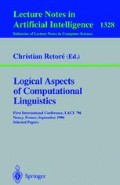Abstract
Constraint logic grammars provide a powerful formalism for expressing complex logical descriptions of natural language phenomena in exact terms. Describing some of these phenomena may, however, require some form of graded distinctions which are not provided by such grammars. Recent approaches to weighted constraint logic grammars attempt to address this issue by adding numerical calculation schemata to the deduction scheme of the underlying CLP framework.
Currently, these extralogical extensions are not related to the model-theoretic counterpart of the operational semantics of CLP, i.e., they do not come with a formal semantics at all.
The aim of this paper is to present a clear formal semantics for weighted constraint logic grammars, which abstracts away from specific interpretations of weights, but nevertheless gives insights into the parsing problem for such weighted grammars. Building on the formalization of constraint logic grammars in the CLP scheme of [11], this formal semantics will be given by a quantitative version of CLP. Such a quantitative CLP scheme can also be valuable for CLP tasks independent of grammars.
I am greatly indebted to Steven Abney, Thilo Götz and Paul King for their valuable comments on this paper. Furthermore, I would like to thank Graham Katz, Frank Morawietz and two anonymous LACL referees for their helpful suggestions.
Preview
Unable to display preview. Download preview PDF.
References
Steven Abney. Statistical methods and linguistics. In Judith Klavans and Philip Resnik, editors, The Balancing Act. The MIT Press, Cambridge, Massachusetts, 1996.
Steven Abney. Stochastic attribute-value grammars. Unpublished manuscript, University of Tübingen, September 1996.
Taylor L. Booth and Richard A. Thompson. Applying probability measures to abstract languages. IEEE Transactions on Computers, C-22(5):442–450, 1973.
Jochen Dörre and Michael Dorna. CUF — a formalism for linguistic knowledge representation. In Jochen Dörre, editor, Computational Aspects of Constraint-Based Linguistic Description I, pages 3–22. DYANA-2 Deliverable R1.2.A, 1993.
Jochen Dörre and Andreas Eisele. A comprehensive unification-based grammar formalism. Technical report, DYANA Deliverable R3.1.B, 1991.
Didier Dubois, JérÔme Lang, and Henri Prade. Towards possibilistic logic programming. In Proceedings of the 8th International Conference on Logic Programming (ICLP '91), pages 581–595, Paris, 1991.
Andreas Eisele. Towards probabilistic extensions of constraint-based grammars. In Jochen Dörre, editor, Computational Aspects of Constraint-Based Linguistic Description II, pages 3–21. DYANA-2 Deliverable R1.2.B, 1994.
Gregor Erbach. Towards a theory of degrees of grammaticality. CLAUS Report 34, Computational Linguistics at the Univerity of the Saarland, 1993.
Gregor Erbach. Bottom-Up Earley Deduction for Preference-Driven Natural Language Processing. PhD thesis, Computational Linguistics, Universität des Saarlandes, Saarbrücken, August 1995.
Thilo Götz. Compiling HPSG constraint grammars into logic programs. In Workshop on Computational Logic and Natural Language Processing, Edinburgh, 1995.
Markus Höhfeld and Gert Smolka. Definite relations over constraint languages. LILOG Report 53, IBM Deutschland, Stuttgart, 1988.
Joxan Jaffar and Jean-Louis Lassez. Constraint logic programming. Technical report 74, Department of Computer Science, Monash University, 1986.
Frank Keller. Extraction from complex noun phrases. A case study in graded grammaticality. Master's thesis, Institut für maschinelle Sprachverarbeitung, Universität Stuttgart, August 1996.
Frank Keller. How do humans deal with ungrammatical input? Experimental evidence and computational modelling. In Dafydd Gibbon, editor, Natural Language Processing and Speech Technology. Results of the 3rd KONVENS Conference, pages 27–34, Berlin, 1996. Mouton de Gruyter.
Michael Kifer and V. S. Subrahmanian. Theory of generalized annotated logic programming and its applications. Journal of Logic Programming, 12:335–367, 1992.
Paul J. King. An expanded logical formalism for head-driven phrase structure grammar. Arbeitspapiere des Sonderforschungsbereichs 340 59, University of Tübingen, 1994.
Laks V. S. Lakshmanan. An epistemic foundation for logic programming with uncertainty. In Proceedings of the 14th Conference on Foundations of Software Technology and Theoretical Computer Science, Madras, India, 1994.
Laks V. S. Lakshmanan and Fereidoon Sadri. Probabilistic deductive databases. In Proceedings of the International Logic Programming Symposium (ILPS '94), Ithaca, NY, 1994.
J. W. Lloyd. Foundations of Logic Programming. Springer, Berlin, 1987.
Raymond Ng and V. S. Subrahmanian. Probabilistic logic programming. Information and Computation, 101:150–201, 1992.
Raymond Ng and V. S. Subrahmanian. A semantical framework for supporting subjective and conditional probabilities in deductive databases. Journal of Automated Reasoning, 10:191–235, 1993.
Nils J. Nilsson. Principles of Artificial Intelligence. Springer, Berlin, Heidelberg, New York, 1982.
Carl Pollard and Ivan A. Sag. Head-Driven Phrase Structure Grammar. University of Chicago Press, Chicago, 1994.
Gert Smolka. A feature logic with subsorts. LILOG Report 33, IBM Deutschland, Stuttgart, 1988.
V. S. Subrahmanian. On the semantics of quantitative logic programs. In Proceedings of the 4th IEEE Symposium on Logic Programming, pages 173–182, Washington D.C., 1987. Computer Society Press.
M. H. van Emden. Quantitative deduction and its fixpoint theory. The Journal of Logic Programming, 1:37–53, 1986.
L. A. Zadeh. Fuzzy sets. Information and Control, 8:338–353, 1965.
Author information
Authors and Affiliations
Editor information
Rights and permissions
Copyright information
© 1997 Springer-Verlag Berlin Heidelberg
About this paper
Cite this paper
Riezler, S. (1997). Quantitative constraint logic programming for weighted grammar applications. In: Retoré, C. (eds) Logical Aspects of Computational Linguistics. LACL 1996. Lecture Notes in Computer Science, vol 1328. Springer, Berlin, Heidelberg. https://doi.org/10.1007/BFb0052166
Download citation
DOI: https://doi.org/10.1007/BFb0052166
Published:
Publisher Name: Springer, Berlin, Heidelberg
Print ISBN: 978-3-540-63700-4
Online ISBN: 978-3-540-69631-5
eBook Packages: Springer Book Archive

